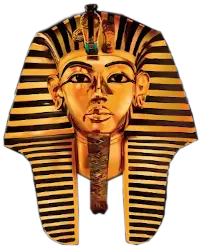
is the source of all, i.e., the Monad of Monads or the God of Gods and (b) the One, i.e., the first in the series of derived numbers or beings. It is opposed to and limited by plurality, and therefore it is relative unity, i.e., a created Monad or God (a Demiurge), consequently the opposition between the One and the many is the source of all the rest. Furthermore, history likewise tells us that the original source of the doctrine of a Demiurge in creation was Egypt, and it dates back to the creation story of Egypt 4000 B.C. which is to be found in the account given by the Memphite Theology: an inscription on a stone, now kept in the British Museum. It contains the theological and cosmological views of the Egyptians which date back to the very beginning of Egyptian history, when the first dynasties had made their new capital at Memphis, the city of the God Ptah, i.e., about 4000 B.C., or even earlier.
The Egyptian cosmology must be presented in three parts; each part being supplementary to the other, and presenting a complete philosophy by their combination. Part (I) deals with the Gods of chaos, part (II) deals with the Gods of order and arrangement in creation, and part (III) deals with the Primate of the Gods, through whose Logos creation was accomplished. In part (I) pre-creation or chaos is represented by (i) Ptah, the Primate of the Gods, emerging from the primeval waters Nun in the form of a Hill, Ta-tjenen, i.e., The Risen Land (ii) Atum, i.e., Atom, the sun God, immediately joining Ptah, by emerging also from the chaotic waters Nun, and sitting upon him (the Hill).
(iii) A description of the other qualities within the chaos follows:--There are four pairs of male and female Gods in the form of frogs and serpents. Their names are (a) Nun and Naunet, the primeval ocean and primeval matter; (b) Huh and Hauhet, the Illimitable and the Boundless, (c) Kuk and Kauket, Darkness and Obscurity; and (d) Amon and Amaunet, the Hidden and concealed ones. (Memphite Theology in Ancient Egyptian Religion by Frankfort, p. 10, p. 21; Frankfort's Intellectual Adventure of Man, p. 10, 21, 52).
Topics
Greek Philospohy is Stolen Egyptian Philosophy
The Memphite Theology is the Basis of all Important Doctrines of Greek Philosophy
Greek Philosophy was Alien to the Greeks
Greek Philosophy was the offspring of the Egyptian Mystery System
The Egyptians Educated the Greeks
The Curriculum of the Egyptian Mystery System
The Pre-Socratic Philosophers and the teaching Ascribed to them
The Athenian Philosophers
1. Socrates
2. Plato
3. Aristotle